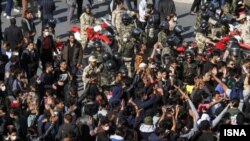The Islamic Revolution Guards Corps' (IRGC) deputy commander for political affairs says the recent anti-regime protests across Iran were "unique," and spread to hundreds of cities in 29 provinces of the country.
"The three-fold increase in gasoline prices triggered the protests on Friday, November 15. The demonstrations were initially limited but gained momentum on Saturday and Sunday, swathing hundreds of cities in 29 out of 31 provinces of the country," Brigadier General Yadollah Javani disclosed.
Javani, notorious for his firm stand against, named Isfahan as one of the provinces where the protests were intense.
"Isfahan, central Iran, witnessed exceptional demonstrations in 110 spots," Javani said, adding, "Only provinces of Fars and Tehran experienced more intense “riots” than Isfahan.
Iranian officials call the protests “riots” and the protesters “thugs” and “bandits”.
However, Javani did not name the two provinces that stayed out of the uprising.
Based on Radio Farda's assessments, the security forces assisted by plainclothesmen killed at least 143 during the recent anti-Islamic Republic protests. Meanwhile, Amnesty International believes that up to 161 protesters fell victim to clashes with the police.
However, a senior advisor to the Islamic Republic's former prime minister and a presidential candidate in 2009, Ardeshir Amir Arjomand told Radio Farda that at least 366 people lost their lives during the protests, insisting that the figure came from a reliable source and was "valid."
Furthermore, the Daily Telegraph in London said in a headline, "Iranian officials 'stealing bodies' from morgues to hide the true scale of government crackdown".
Javani portrayed the protests as unprecedented. "The dimension and broadness of the recent protests were unprecedented in the four-decade-old history of the Islamic Republic. We had experienced protests during the first months after the Islamic revolution, but they were limited to ethnic uprisings. Furthermore, the volume of attacks on public properties and setting banks and Basij (IRGC"s militia force) bases on fire, was much higher than the rallies in 2009 and 2017 riots," Javani said.
Referring to the Islamic Republic Supreme Leader Ali Khamenei’s recent remarks about a foreign plot, Javani claimed that a triangle is behind the unrest in Iran.
"The triangle is composed of its two designers, Israel and the U.S., financial support provided by Saudi Arabia, and those who implement the plots; i.e., the anti-Islamic Revolution elements in Iran," Javani expanded.







